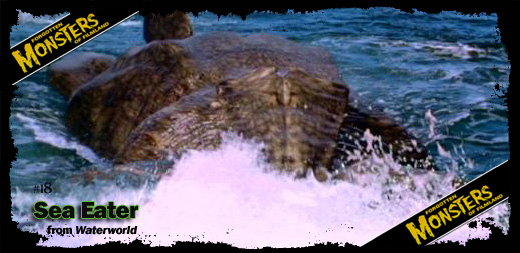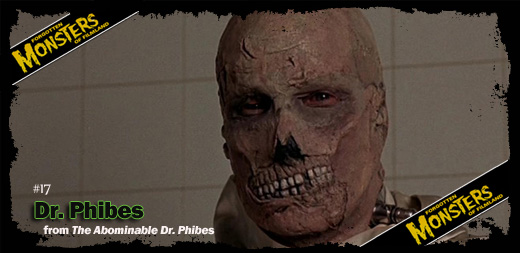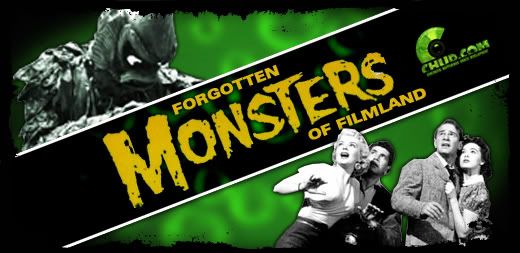Frankenstein’s Monster. Dracula. Freddy Krueger. Leatherface. Godzilla. Henry Kissinger. These are some of the monsters whose names get evoked every year at Halloween, the monsters with the highest Q ratings and maybe their own personal publicists. But there are many more monsters out there, monsters who kill, terrorize and stalk their prey far outside of the limelight. For the next few weeks, we’re going to be paying tribute to these Forgotten Monsters of Filmland.
Some of these monsters are just a successful film away from making the mainstream. Some were more popular years ago and have fallen out of favor. Some are just sort of utterly bizarre. Some of these monsters will be familiar to the loyal readers of CHUD.com, while others will make just about everybody scratch their head. All of them deserve more love. That’s where we come in.

“I am. I chomped Costner. I was.”
Name: Sea Eater
AKA: Swallows with Regret, Tripplehorn Bait, Unfinished CG.
Appearances: Waterworld (1995)
Monster Type: Big ‘n Brief
Its Place in the Film: Out of the deep it came, hungry for Ford, but more than willing to settle for Costner; a few seconds later, hamartia steaks are being served.’ As for how the balding, bellicose, be-gilled “Mariner” makes it out of this creature’s tummy alive, that’s a task either too gory or too involved for even a $175 million budget to explicate.’ As a result, this would-be devour of a movie star in decline is gone almost as soon as he surfaces; and it’s a shame because if there’s one thing the flagging middle section of Waterworld could’ve used, it’s a famished, pissed-off sea monster.’ So the audience is left to consider what might’ve been; maybe the screenplay credited to Peter Rader and David Twohy (though tinkered with by many) contains an excised scene in which The Mariner and the Sea Eater make like Quint and Hooper, and share genetic mutations before getting on with the age-old drama of not-quite-man versus not-quite-anything.’
Distinguishing Characteristics: Slimy, lumpen and gone.
Why It Is Forgotten: Quiz anyone who’s seen Waterworld only once, and there’s a very good chance they don’t even remember this magnificent beast.’ The f/x artists at ILM are probably very pleased with this.
Why It Shouldn’t Be Forgotten: Waterworld averages about one disappointment per $1 million U.S., but this hulking slab of… somethin’ ain’t one of ’em (even though the most attentive viewer had to wait for VCR to confirm its existence).

Alan Moore’s real face.
Name: Dr. Phibes
AKA: The King Of Pop. Not My Real Eyes. P For Vendetta.
Appearances: The Abominable Dr. Phibes (1971)
Monster Type: Organ Donor.
Its Place in the Film: Dr. Phibes was a famous musician thought killed in an auto accident while racing to the side of his ill wife. He didn’t die ‘ he just got better looking ‘ but she did, leading Phibes to swear vengeance on the team of doctors he believed responsible. Luckily there are enough victims that he can turn to a list of Biblical plagues for inspiration. Everyone gets into that old saw. With the last doctor’s son on the operating table and a vat of acid set to pour onto the kid’s face if dad can’t free him by extracting the key implanted near his heart, Phibes tears off the Michael Jackson nose and skin to reveal his pretty average-looking disfigured self. He’d be a lot more intimidating if his leftover skin was actually as green as in the poster.
Distinguishing Characteristics: Looks like Vincent Price without skin. Talks like Uncle Larry after the operation. No health care. Bible reader.
Why It Is Forgotten: The Abominable Dr. Phibes would be a lot like The Adventures of Buckaroo Banzai if Peter Weller played the organ instead of the guitar, killed people instead of saved them, and didn’t have a face or Perfect Tommy. In fact, Dr. Phibes isn’t so much a horror film as a detective story / melodramatic thriller / medical procedural / ode to organs.
Why It Shouldn’t Be Forgotten: As I was obsessing over the game BioShock late this summer, little images kept triggering associations for me. Turns out parts of the game are a dead ringer for this campy little flick: the deco setting, the surgical theatres and the smashing of plastered heads and faces. (Probably coincidence, but I don’t care.) Not that the film isn’t worth remembering on its own; the plagues are well-done and no one in the film actually thinks they’re making something of quality. Not even Joseph Cotton. And how can you not dig on Vincent Price delivering all his dialogue in voice-over, thanks to his character’s throat being permanently on the fritz?
– Russ Fischer
